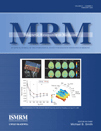Broadband slab selection with B mitigation at 7T via parallel spectral-spatial excitation
mitigation at 7T via parallel spectral-spatial excitation
Abstract
Chemical shift imaging benefits from signal-to-noise ratio (SNR) and chemical shift dispersion increases at stronger main field such as 7 Tesla, but the associated shorter radiofrequency (RF) wavelengths encountered require B mitigation over both the spatial field of view (FOV) and a specified spectral bandwidth. The bandwidth constraint presents a challenge for previously proposed spatially tailored B
mitigation over both the spatial field of view (FOV) and a specified spectral bandwidth. The bandwidth constraint presents a challenge for previously proposed spatially tailored B mitigation methods, which are based on a type of echovolumnar trajectory referred to as “spokes” or “fast-kz”. Although such pulses, in conjunction with parallel excitation methodology, can efficiently mitigate large B
mitigation methods, which are based on a type of echovolumnar trajectory referred to as “spokes” or “fast-kz”. Although such pulses, in conjunction with parallel excitation methodology, can efficiently mitigate large B inhomogeneities and achieve relatively short pulse durations with slice-selective excitations, they exhibit a narrow-band off-resonance response and may not be suitable for applications that require B
inhomogeneities and achieve relatively short pulse durations with slice-selective excitations, they exhibit a narrow-band off-resonance response and may not be suitable for applications that require B mitigation over a large spectral bandwidth. This work outlines a design method for a general parallel spectral-spatial excitation that achieves a target-error minimization simultaneously over a bandwidth of frequencies and a specified spatial-domain. The technique is demonstrated for slab-selective excitation with in-plane B
mitigation over a large spectral bandwidth. This work outlines a design method for a general parallel spectral-spatial excitation that achieves a target-error minimization simultaneously over a bandwidth of frequencies and a specified spatial-domain. The technique is demonstrated for slab-selective excitation with in-plane B mitigation over a 600-Hz bandwidth. The pulse design method is validated in a water phantom at 7T using an eight-channel transmit array system. The results show significant increases in the pulse's spectral bandwidth, with no additional pulse duration penalty and only a minor tradeoff in spatial B
mitigation over a 600-Hz bandwidth. The pulse design method is validated in a water phantom at 7T using an eight-channel transmit array system. The results show significant increases in the pulse's spectral bandwidth, with no additional pulse duration penalty and only a minor tradeoff in spatial B mitigation compared to the standard spoke-based parallel RF design. Magn Reson Med 61:493–500, 2009. © 2009 Wiley-Liss, Inc.
mitigation compared to the standard spoke-based parallel RF design. Magn Reson Med 61:493–500, 2009. © 2009 Wiley-Liss, Inc.




